2013 Cadillac XTS vs. 2012 Bentley Continental Flying Spur Speed

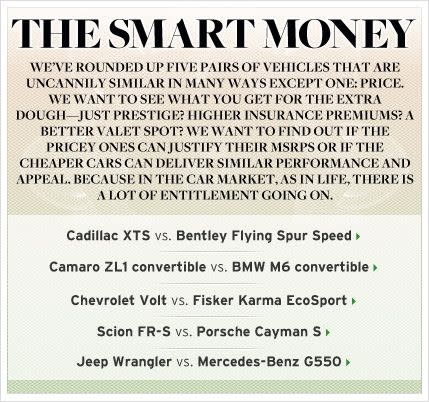


Everything luxurious begins as something unpretentious. Hermès started as a harness workshop. Louis Vuitton luggage is just animal hide that protects your silk teddy from filthy TSA fingers. Luxury is about elevating an experience or a set of components—pushing well past mere utility to a place that makes you say “ahh.” Luxury is an escape, a transcendence of basic function.
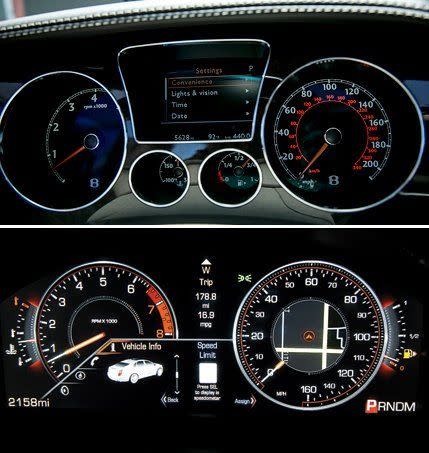
Under its Cadillac skin, the new XTS conceals the skeleton of a Buick LaCrosse, which itself branches off the same family tree as the Chevrolet Malibu. And here’s the similarity: Bentley’s Continental Flying Spur also springs from humble roots. The Flying Spur shares its architecture with the defunct-in-the-U.S. Volkswagen Phaeton. So the Bentley is to a $70,000 VW as the Cadillac is to a $20,000 Chevy. Yes, the Bentley’s VW underpinnings are arguably more solid and refined—pricier, even—than the XTS. We’re not here to dispute that. What we seek to compare is the degree to which Bentley and Cadillac have sculpted the lumps of clay they were handed.
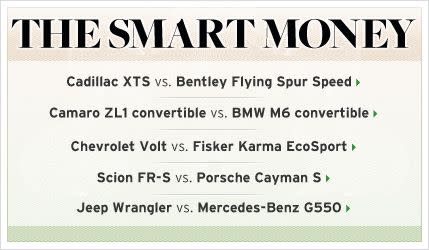
A Bentley buyer would likely turn up his nose at the XTS, Platinum badge or not. But not so fast, Thurston Howell III—aim that monocle at the Platinum’s interior. Where lesser XTS models make do with synthetic surface treatments, Platinum means you get real leather throughout. Precisely stitched and butter-soft, the leather on the instrument panel extends into the tops of the doors, eventually retreating to give way to sapele wood panels inlaid with a different, darker “Lineate” wood. Leather covering aside, the seats still have a puffy, slightly overstuffed appearance that doesn’t adhere to the current European definition of luxury-car style. No matter, they’re comfy and heated and cooled. The British car doesn’t have cooled seats.
You’ll need the cooled seats because the knob-less CUE system will have you steaming as soon as you try to change the radio station or adjust the volume. If luxury means never having to do so much as push a button, then this is the most luxurious car in the world. But, clearly, that aphorism is outmoded. An eight-inch touch screen sits above a button-free panel that technical editor Aaron Robinson describes as a “Transformer’s codpiece.” Complex commands are handled admirably; pairing a phone is relatively easy, and entering a destination requires no undue effort. It’s the interactions you expect to be simple, things you do often, that prove frustrating. You tune the radio through the touch screen and only when you’re on the audio view. Hitting an ersatz iPad while driving isn’t as easy as it sounds. Also, the touch screen—and the HVAC and other touch-sensitive controls below it—doesn’t reliably respond to your finger. From the logbook: “Dear Cadillac, volume and tuning knobs would be a real luxury.”
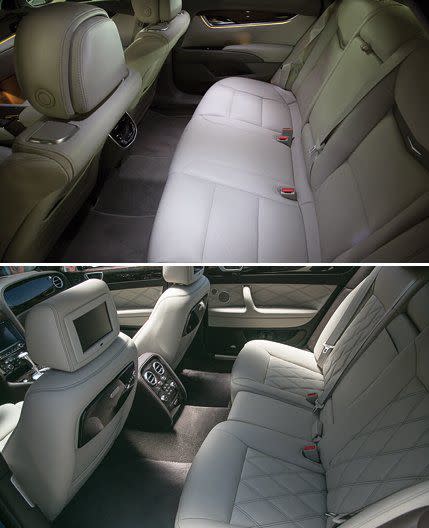
The instruments are configurable four ways, from a simple digital speedo to virtual analog gauges. You’ll find the version you like and never change it. A multicolor head-up display also offers a few different settings and can provide speed-limit information and navigation directions. The speed-limit reminder is welcome, as this Cadillac masks highway-speed sensations and offers up only 66 decibels of noise at 70 mph.
What the sound-level meter can’t quite detect is the hollow and occasionally gritty feel that comes up through the XTS’s bones. Standard magnetorheological shocks tighten and soften the ride depending on the situation. But despite the dampers’ admirable efforts, the structure reverberates, a reminder of the XTS’s family-car roots.
Quick steering (2.6 turns lock-to-lock) flings the XTS into corners. Actually, flinging might be overstating it a bit, but next to a 5482-pound leviathan such as the Bentley, the 4114-pound XTS feels small and tidy. Weight advantage aside, the Caddy has 304 horsepower to the Flying Spur’s 600. In a drag race, the Bentley easily walks away from the XTS and its 6.9-second 0-to-60 time. A dearth of low-end torque means the V-6 needs to spin beyond 5000 rpm to find motivation. Fortunately, the six-speed automatic has a gear for nearly every situation and the 3.6-liter V-6 revs with true eagerness, even if chasing the Bentley took every ounce of its capability. Fuel economy suffered; the XTS could only match its 17-mpg EPA city number. Even with half the power, predictable handling and usable grip kept the XTS ever present in the Bentley’s rearview mirror in the canyons above Los Angeles.
At nearly $60,000, we’d like a bit more power and less effort. Cadillac loads the XTS Platinum with features and leather and offers all-wheel drive as an option, but the front-drive family-sedan character is still present. Not enough sculpting has occurred. Luxury cars should offer more than extra features; they should elevate the entire experience. The XTS never feels cheap, but it doesn’t feel expensive, either, and we kept wishing it cost closer to two Malibus rather than three.

From the moment a door glides open, it’s obvious where the money went. Out wafts the earthy scent of high-quality leather goods. To get this bouquet in the Cadillac, you’d have to leave 100 Coach wallets and 200 Gucci loafers inside. Nine entire bull hides are stretched and stitched together for the Flying Spur’s interior. It takes 75 hours to craft the cabin leather: Stitching together the steering wheel takes four hours, and the seats (ours wore a diamond pattern) require 30. Bentley employs 12 seamstresses in its leather shop. Even the massive headliner is leather.
Over in the wood shop, craftsmen carefully select 35 walnut panels that add up to nine square yards of surface area. Our car added veneered picnic tables for $2685. The Spur Speed’s grand total neared a quarter-million dollars—leather and wood shops don’t pay for themselves. Buy a Bentley, and you become a benevolent job creator. Indeed, everyone assumes you belong to the job-creating class when they gaze upon the flawless exterior—it takes 12 hours of sanding and polishing to achieve that deep finish. Our cigar-colored (Havana Metallic) Flying Spur had valets drooling, but they also expect you to tip generously. Don’t, and you’ll hear nasty words thrown in your wake. Pretenders like us can’t afford that kind of responsibility.
According to the EPA, the Flying Spur Speed will exact $4230 a year in gas alone. During our test, the colossus under the hood drank a gallon every 14 miles. Yes, the engine is essentially two Volkswagen VR-6s stuck together like Siamese twins, but that’s like saying the Bugatti Veyron’s mill is simply two Volkswagen W-8s. There’s some truthiness to this, but it’s not the whole story.
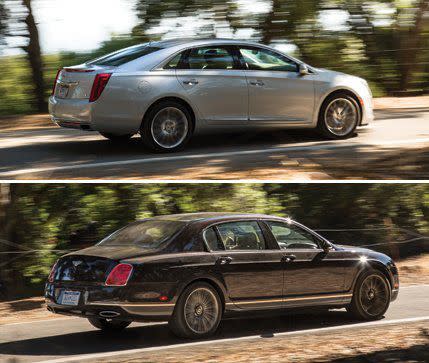
Nine hours are required to put together the Speed’s 600-hp twin-turbo W-12 (the Phaeton’s W-12 is rated at 450 horses). It generates more torque (355 pound-feet) at 1000 rpm than the Cadillac musters at its peak. Low-end power is strong, but then the boost tops out at about 4000 rpm and you’re pressed against the leather shop’s finest. This Flying Spur Speed proved slightly slower than the last one we tested [September 2010]. A few ponies may have fallen victim to California’s 91-octane gas (our previous test car quaffed magnums of 93 octane). Still, the Speed hit 60 mph in 4.7 seconds and conquered the quarter-mile in 13.2 seconds at 108 mph. Those are respectable numbers for a dedicated performance car.
Sports-car-like brakes stop the Bentley train from 70 mph in 161 feet, again and again. Handling is similarly astounding. Huge Pirelli P Zeros designed just for Bentley gripped the skidpad at a tenacious 0.88 g. The car’s balance is like that of a front-driver; it plows at the limit, but the all-wheel drive thrusts it smartly out of corners. Nothing really disturbs the ride or the structure. Contained within those 5482 pounds are both a limousine and a sports car.
Even though the Flying Spur Speed costs more than four times as much as the XTS, it’s still the winner. Its performance and finish are commensurate with its price and, to our point about humbler origins, banish all thoughts of the Phaeton within. Too often, the Cadillac exposes its family-sedan roots. For nearly $60K, we’d like to forget that family sedans exist. The XTS is a much better deal when it’s closer to its $44,995 base price, but then you’d miss the special gauges and the leather-trimmed interior. Yes, the Bentley costs an absurd amount of money. But it delivers an unparalleled luxury experience. Every drive in the Bentley is an escape from reality, an occasion. Consider this: If you tried to decorate a room in your house to the material and craftsmanship standards of the Flying Spur, it might cost more than the car. And no room in the universe hits 60 in 4.7 seconds.
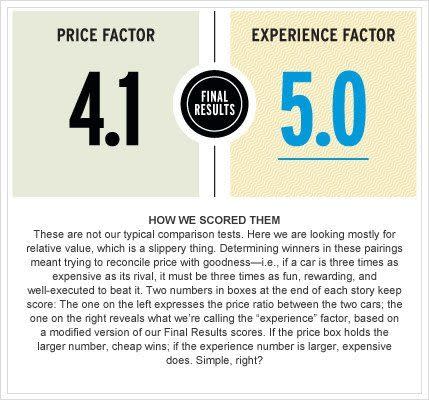

You Might Also Like

 Yahoo Autos
Yahoo Autos 